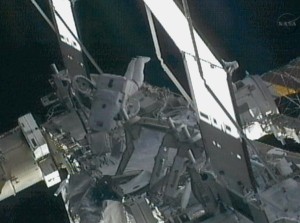
WASHINGTON—Galactic tourism may still be a daydream for most of us, but for anyone interested in a glimpse of the International Space Station sooner, NASA is ready to help.
The US space agency, celebrating the 12th anniversary of astronauts living and working on the orbiting lab, launched a new service Friday that alerts people when the space station is visible from their backyard.
Those who sign up will get an email or a text message with a few hours warning.
Then, when the moment is right, NASA said, you just go outside and look up — no fancy equipment required.
“It’s really remarkable to see the space station fly overhead and to realize humans built an orbital complex that can be spotted from Earth by almost anyone looking up at just the right moment,” William Gerstenmaier, NASA’s associate administrator for human exploration and operations, said in a statement.
The space station is typically visible right at dawn or dusk, when the moon is the only brighter object visible in the night sky, NASA said.
It looks like a fast moving point of light, similar to Venus.
“Spot the Station” service is available worldwide, the agency said, adding the station’s trajectory carries it over more than 90 percent of the Earth’s population.
To sign up, visit spotthestation.nasa.gov.













































